
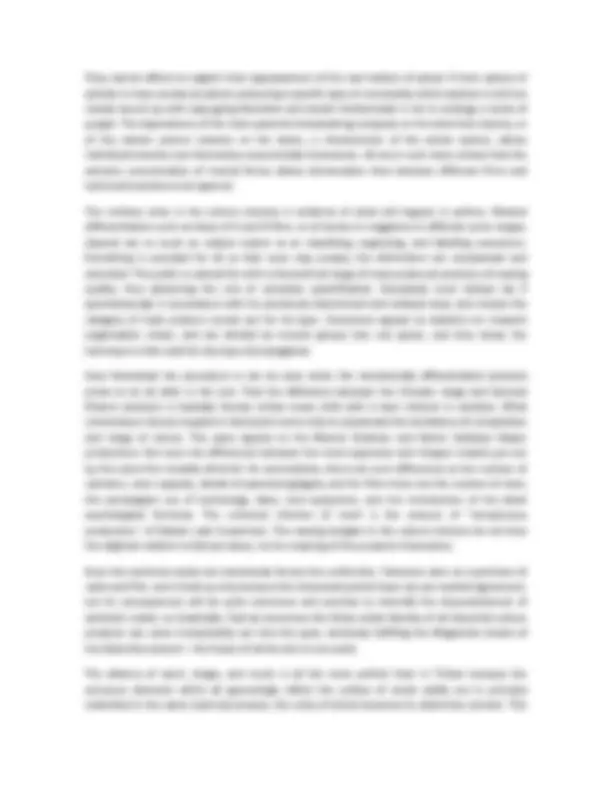

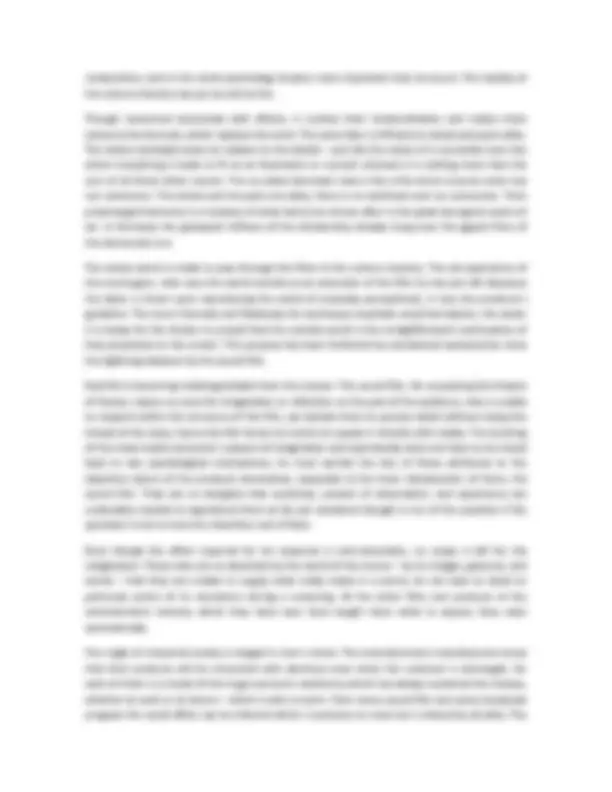
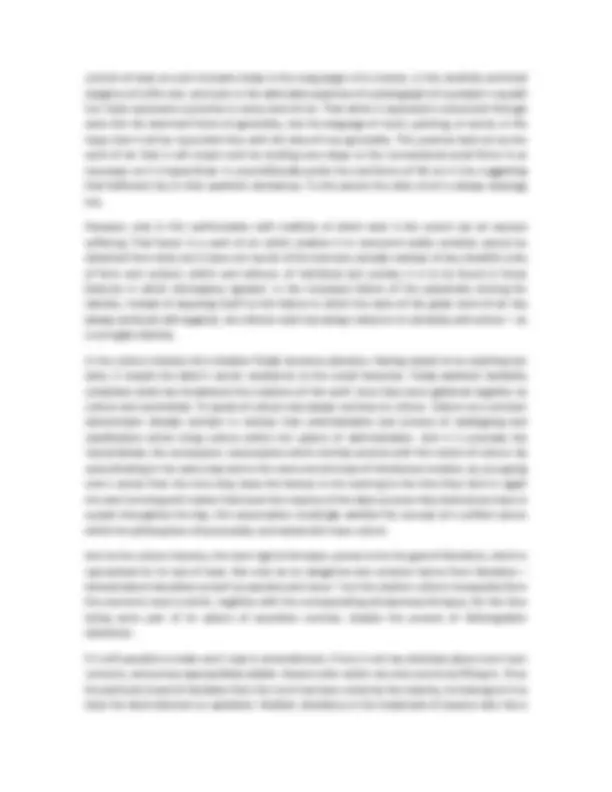

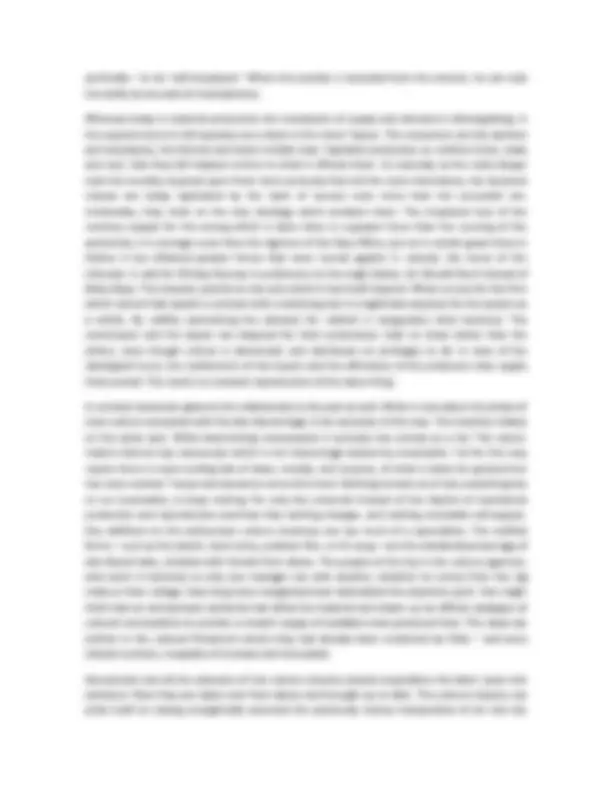

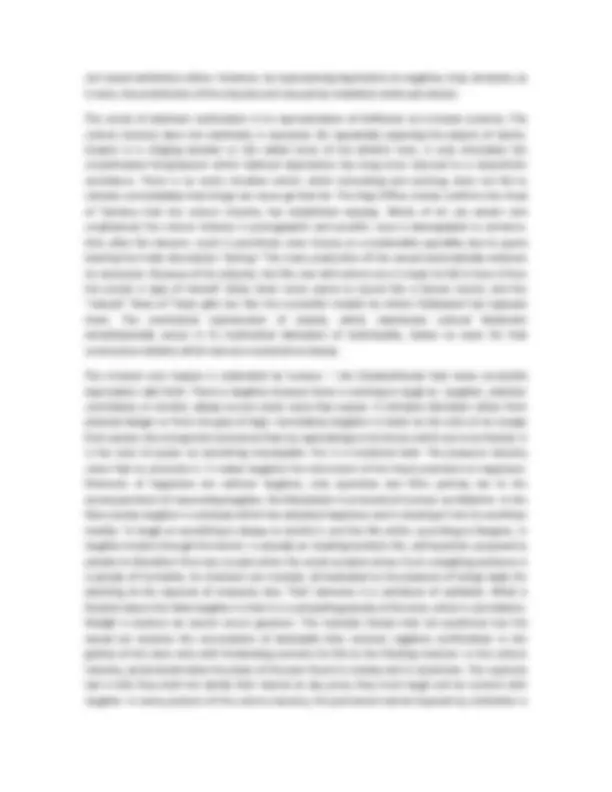
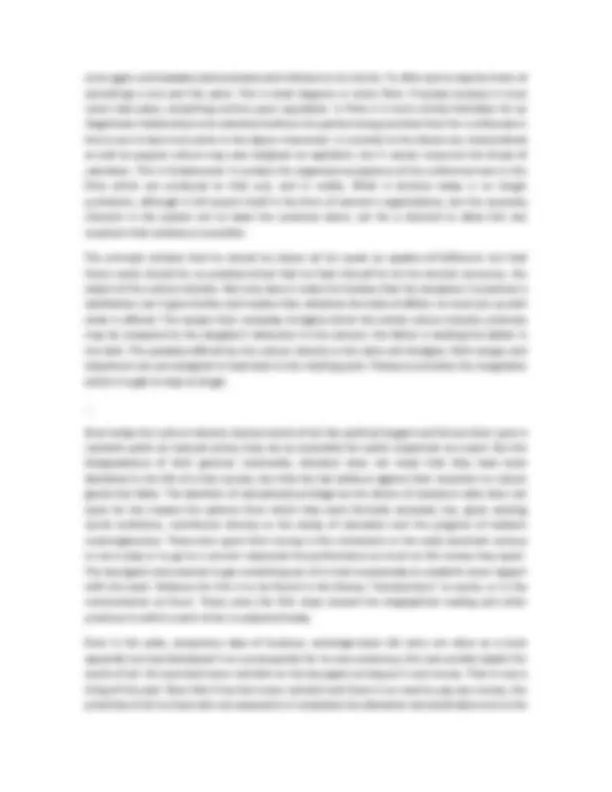
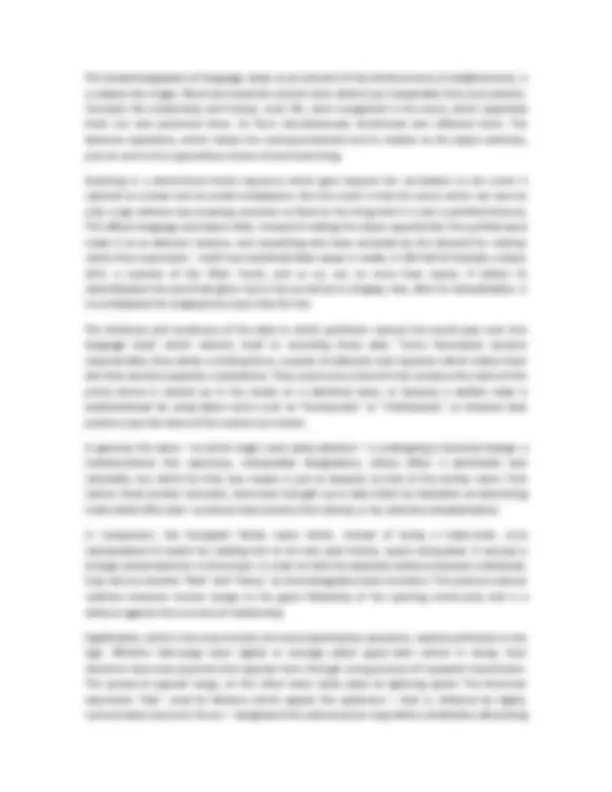
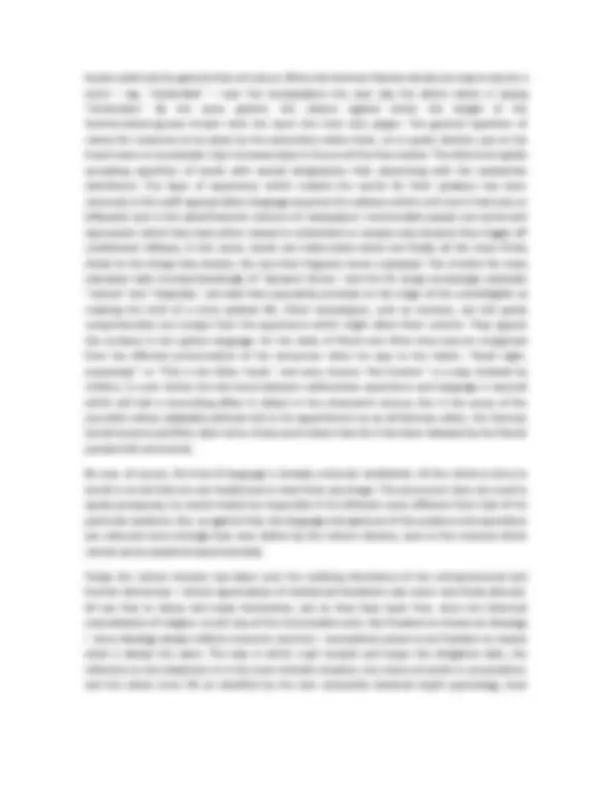



Study with the several resources on Docsity

Earn points by helping other students or get them with a premium plan


Prepare for your exams
Study with the several resources on Docsity

Earn points to download
Earn points by helping other students or get them with a premium plan
Community
Ask the community for help and clear up your study doubts
Discover the best universities in your country according to Docsity users
Free resources
Download our free guides on studying techniques, anxiety management strategies, and thesis advice from Docsity tutors
This document critiques the homogenization of culture in mass society, arguing that the culture industry's focus on satisfying the needs of the masses results in a lack of authenticity and style in art. The author discusses how culture monopolies are dependent on the power elite and how television aims to synthesize radio and film, leading to the eventual fusion of all industrial culture products.
What you will learn
Typology: Schemes and Mind Maps
1 / 20

This page cannot be seen from the preview
Don't miss anything!













Theodor Adorno and Max Horkheimer (1944)
Source: most of one chapter from Dialectic of Enlightenment ; Transcribed: by Andy Blunden 1998; proofed and corrected Feb. 2005.
THE sociological theory that the loss of the support of objectively established religion, the dissolution of the last remnants of pre-capitalism, together with technological and social differentiation or specialisation, have led to cultural chaos is disproved every day; for culture now impresses the same stamp on everything.
Films, radio and magazines make up a system which is uniform as a whole and in every part. Even the aesthetic activities of political opposites are one in their enthusiastic obedience to the rhythm of the iron system. The decorative industrial management buildings and exhibition centers in authoritarian countries are much the same as anywhere else. The huge gleaming towers that shoot up everywhere are outward signs of the ingenious planning of international concerns, toward which the unleashed entrepreneurial system (whose monuments are a mass of gloomy houses and business premises in grimy, spiritless cities) was already hastening. Even now the older houses just outside the concrete city centres look like slums, and the new bungalows on the outskirts are at one with the flimsy structures of world fairs in their praise of technical progress and their built-in demand to be discarded after a short while like empty food cans.
Yet the city housing projects designed to perpetuate the individual as a supposedly independent unit in a small hygienic dwelling make him all the more subservient to his adversary – the absolute power of capitalism. Because the inhabitants, as producers and as consumers, are drawn into the center in search of work and pleasure, all the living units crystallise into well-organised complexes. The striking unity of microcosm and macrocosm presents men with a model of their culture: the false identity of the general and the particular. Under monopoly all mass culture is identical, and the lines of its artificial framework begin to show through. The people at the top are no longer so interested in concealing monopoly: as its violence becomes more open, so its power grows. Movies and radio need no longer pretend to be art. The truth that they are just business is made into an ideology in order to justify the rubbish they deliberately produce. They call themselves industries; and when their directors’ incomes are published, any doubt about the social utility of the finished products is removed.
Interested parties explain the culture industry in technological terms. It is alleged that because millions participate in it, certain reproduction processes are necessary that inevitably require identical needs in innumerable places to be satisfied with identical goods. The technical contrast
between the few production centers and the large number of widely dispersed consumption points is said to demand organisation and planning by management. Furthermore, it is claimed that standards were based in the first place on consumers’ needs, and for that reason were accepted with so little resistance. The result is the circle of manipulation and retroactive need in which the unity of the system grows ever stronger. No mention is made of the fact that the basis on which technology acquires power over society is the power of those whose economic hold over society is greatest. A technological rationale is the rationale of domination itself. It is the coercive nature of society alienated from itself. Automobiles, bombs, and movies keep the whole thing together until their leveling element shows its strength in the very wrong which it furthered. It has made the technology of the culture industry no more than the achievement of standardisation and mass production, sacrificing whatever involved a distinction between the logic of the work and that of the social system.
This is the result not of a law of movement in technology as such but of its function in today’s economy. The need which might resist central control has already been suppressed by the control of the individual consciousness. The step from the telephone to the radio has clearly distinguished the roles. The former still allowed the subscriber to play the role of subject, and was liberal. The latter is democratic: it turns all participants into listeners and authoritatively subjects them to broadcast programs which are all exactly the same. No machinery of rejoinder has been devised, and private broadcasters are denied any freedom. They are confined to the apocryphal field of the “amateur,” and also have to accept organisation from above.
But any trace of spontaneity from the public in official broadcasting is controlled and absorbed by talent scouts, studio competitions and official programs of every kind selected by professionals. Talented performers belong to the industry long before it displays them; otherwise they would not be so eager to fit in. The attitude of the public, which ostensibly and actually favours the system of the culture industry, is a part of the system and not an excuse for it. If one branch of art follows the same formula as one with a very different medium and content; if the dramatic intrigue of broadcast soap operas becomes no more than useful material for showing how to master technical problems at both ends of the scale of musical experience – real jazz or a cheap imitation; or if a movement from a Beethoven symphony is crudely “adapted” for a film sound-track in the same way as a Tolstoy novel is garbled in a film script: then the claim that this is done to satisfy the spontaneous wishes of the public is no more than hot air.
We are closer to the facts if we explain these phenomena as inherent in the technical and personnel apparatus which, down to its last cog, itself forms part of the economic mechanism of selection. In addition there is the agreement – or at least the determination – of all executive authorities not to produce or sanction anything that in any way differs from their own rules, their own ideas about consumers, or above all themselves.
In our age the objective social tendency is incarnate in the hidden subjective purposes of company directors, the foremost among whom are in the most powerful sectors of industry – steel, petroleum, electricity, and chemicals. Culture monopolies are weak and dependent in comparison.
process integrates all the elements of the production, from the novel (shaped with an eye to the film) to the last sound effect. It is the triumph of invested capital, whose title as absolute master is etched deep into the hearts of the dispossessed in the employment line; it is the meaningful content of every film, whatever plot the production team may have selected.
The man with leisure has to accept what the culture manufacturers offer him. Kant’s formalism still expected a contribution from the individual, who was thought to relate the varied experiences of the senses to fundamental concepts; but industry robs the individual of his function. Its prime service to the customer is to do his schematising for him.
Kant said that there was a secret mechanism in the soul which prepared direct intuitions in such a way that they could be fitted into the system of pure reason. But today that secret has been deciphered. While the mechanism is to all appearances planned by those who serve up the data of experience, that is, by the culture industry, it is in fact forced upon the latter by the power of society, which remains irrational, however we may try to rationalise it; and this inescapable force is processed by commercial agencies so that they give an artificial impression of being in command.
There is nothing left for the consumer to classify. Producers have done it for him. Art for the masses has destroyed the dream but still conforms to the tenets of that dreaming idealism which critical idealism baulked at. Everything derives from consciousness: for Malebranche and Berkeley, from the consciousness of God; in mass art, from the consciousness of the production team. Not only are the hit songs, stars, and soap operas cyclically recurrent and rigidly invariable types, but the specific content of the entertainment itself is derived from them and only appears to change. The details are interchangeable. The short interval sequence which was effective in a hit song, the hero’s momentary fall from grace (which he accepts as good sport), the rough treatment which the beloved gets from the male star, the latter’s rugged defiance of the spoilt heiress, are, like all the other details, ready-made clichés to be slotted in anywhere; they never do anything more than fulfil the purpose allotted them in the overall plan. Their whole raison d’être is to confirm it by being its constituent parts. As soon as the film begins, it is quite clear how it will end, and who will be rewarded, punished, or forgotten. In light music, once the trained ear has heard the first notes of the hit song, it can guess what is coming and feel flattered when it does come. The average length of the short story has to be rigidly adhered to. Even gags, effects, and jokes are calculated like the setting in which they are placed. They are the responsibility of special experts and their narrow range makes it easy for them to be apportioned in the office.
The development of the culture industry has led to the predominance of the effect, the obvious touch, and the technical detail over the work itself – which once expressed an idea, but was liquidated together with the idea. When the detail won its freedom, it became rebellious and, in the period from Romanticism to Expressionism, asserted itself as free expression, as a vehicle of protest against the organisation. In music the single harmonic effect obliterated the awareness of form as a whole; in painting the individual colour was stressed at the expense of pictorial
composition; and in the novel psychology became more important than structure. The totality of the culture industry has put an end to this.
Though concerned exclusively with effects, it crushes their insubordination and makes them subserve the formula, which replaces the work. The same fate is inflicted on whole and parts alike. The whole inevitably bears no relation to the details – just like the career of a successful man into which everything is made to fit as an illustration or a proof, whereas it is nothing more than the sum of all those idiotic events. The so-called dominant idea is like a file which ensures order but not coherence. The whole and the parts are alike; there is no antithesis and no connection. Their prearranged harmony is a mockery of what had to be striven after in the great bourgeois works of art. In Germany the graveyard stillness of the dictatorship already hung over the gayest films of the democratic era.
The whole world is made to pass through the filter of the culture industry. The old experience of the movie-goer, who sees the world outside as an extension of the film he has just left (because the latter is intent upon reproducing the world of everyday perceptions), is now the producer’s guideline. The more intensely and flawlessly his techniques duplicate empirical objects, the easier it is today for the illusion to prevail that the outside world is the straightforward continuation of that presented on the screen. This purpose has been furthered by mechanical reproduction since the lightning takeover by the sound film.
Real life is becoming indistinguishable from the movies. The sound film, far surpassing the theatre of illusion, leaves no room for imagination or reflection on the part of the audience, who is unable to respond within the structure of the film, yet deviate from its precise detail without losing the thread of the story; hence the film forces its victims to equate it directly with reality. The stunting of the mass-media consumer’s powers of imagination and spontaneity does not have to be traced back to any psychological mechanisms; he must ascribe the loss of those attributes to the objective nature of the products themselves, especially to the most characteristic of them, the sound film. They are so designed that quickness, powers of observation, and experience are undeniably needed to apprehend them at all; yet sustained thought is out of the question if the spectator is not to miss the relentless rush of facts.
Even though the effort required for his response is semi-automatic, no scope is left for the imagination. Those who are so absorbed by the world of the movie – by its images, gestures, and words – that they are unable to supply what really makes it a world, do not have to dwell on particular points of its mechanics during a screening. All the other films and products of the entertainment industry which they have seen have taught them what to expect; they react automatically.
The might of industrial society is lodged in men’s minds. The entertainments manufacturers know that their products will be consumed with alertness even when the customer is distraught, for each of them is a model of the huge economic machinery which has always sustained the masses, whether at work or at leisure – which is akin to work. From every sound film and every broadcast program the social effect can be inferred which is exclusive to none but is shared by all alike. The
the trade, he is forgiven because his departures from the norm are regarded as calculated mutations which serve all the more strongly to confirm the validity of the system. The constraint of the technically-conditioned idiom which stars and directors have to produce as “nature” so that the people can appropriate it, extends to such fine nuances that they almost attain the subtlety of the devices of an avant-garde work as against those of truth. The rare capacity minutely to fulfil the obligations of the natural idiom in all branches of the culture industry becomes the criterion of efficiency. What and how they say it must be measurable by everyday language, as in logical positivism.
The producers are experts. The idiom demands an astounding productive power, which it absorbs and squanders. In a diabolical way it has overreached the culturally conservative distinction between genuine and artificial style. A style might be called artificial which is imposed from without on the refractory impulses of a form. But in the culture industry every element of the subject matter has its origin in the same apparatus as that jargon whose stamp it bears. The quarrels in which the artistic experts become involved with sponsor and censor about a lie going beyond the bounds of credibility are evidence not so much of an inner aesthetic tension as of a divergence of interests. The reputation of the specialist, in which a last remnant of objective independence sometimes finds refuge, conflicts with the business politics of the Church, or the concern which is manufacturing the cultural commodity. But the thing itself has been essentially objectified and made viable before the established authorities began to argue about it. Even before Zanuck acquired her, Saint Bernadette was regarded by her latter-day hagiographer as brilliant propaganda for all interested parties. That is what became of the emotions of the character. Hence the style of the culture industry, which no longer has to test itself against any refractory material, is also the negation of style. The reconciliation of the general and particular, of the rule and the specific demands of the subject matter, the achievement of which alone gives essential, meaningful content to style, is futile because there has ceased to be the slightest tension between opposite poles: these concordant extremes are dismally identical; the general can replace the particular, and vice versa.
Nevertheless, this caricature of style does not amount to something beyond the genuine style of the past. In the culture industry the notion of genuine style is seen to be the aesthetic equivalent of domination. Style considered as mere aesthetic regularity is a romantic dream of the past. The unity of style not only of the Christian Middle Ages but of the Renaissance expresses in each case the different structure of social power, and not the obscure experience of the oppressed in which the general was enclosed. The great artists were never those who embodied a wholly flawless and perfect style, but those who used style as a way of hardening themselves against the chaotic expression of suffering, as a negative truth. The style of their works gave what was expressed that force without which life flows away unheard. Those very art forms which are known as classical, such as Mozart’s music, contain objective trends which represent something different to the style which they incarnate.
As late as Schönberg and Picasso, the great artists have retained a mistrust of style, and at crucial points have subordinated it to the logic of the matter. What Dadaists and Expressionists called the
untruth of style as such triumphs today in the sung jargon of a crooner, in the carefully contrived elegance of a film star, and even in the admirable expertise of a photograph of a peasant’s squalid hut. Style represents a promise in every work of art. That which is expressed is subsumed through style into the dominant forms of generality, into the language of music, painting, or words, in the hope that it will be reconciled thus with the idea of true generality. This promise held out by the work of art that it will create truth by lending new shape to the conventional social forms is as necessary as it is hypocritical. It unconditionally posits the real forms of life as it is by suggesting that fulfilment lies in their aesthetic derivatives. To this extent the claim of art is always ideology too.
However, only in this confrontation with tradition of which style is the record can art express suffering. That factor in a work of art which enables it to transcend reality certainly cannot be detached from style; but it does not consist of the harmony actually realised, of any doubtful unity of form and content, within and without, of individual and society; it is to be found in those features in which discrepancy appears: in the necessary failure of the passionate striving for identity. Instead of exposing itself to this failure in which the style of the great work of art has always achieved self-negation, the inferior work has always relied on its similarity with others – on a surrogate identity.
In the culture industry this imitation finally becomes absolute. Having ceased to be anything but style, it reveals the latter’s secret: obedience to the social hierarchy. Today aesthetic barbarity completes what has threatened the creations of the spirit since they were gathered together as culture and neutralised. To speak of culture was always contrary to culture. Culture as a common denominator already contains in embryo that schematisation and process of cataloguing and classification which bring culture within the sphere of administration. And it is precisely the industrialised, the consequent, subsumption which entirely accords with this notion of culture. By subordinating in the same way and to the same end all areas of intellectual creation, by occupying men’s senses from the time they leave the factory in the evening to the time they clock in again the next morning with matter that bears the impress of the labor process they themselves have to sustain throughout the day, this subsumption mockingly satisfies the concept of a unified culture which the philosophers of personality contrasted with mass culture.
And so the culture industry, the most rigid of all styles, proves to be the goal of liberalism, which is reproached for its lack of style. Not only do its categories and contents derive from liberalism – domesticated naturalism as well as operetta and revue – but the modern culture monopolies form the economic area in which, together with the corresponding entrepreneurial types, for the time being some part of its sphere of operation survives, despite the process of disintegration elsewhere.
It is still possible to make one’s way in entertainment, if one is not too obstinate about one’s own concerns, and proves appropriately pliable. Anyone who resists can only survive by fitting in. Once his particular brand of deviation from the norm has been noted by the industry, he belongs to it as does the land-reformer to capitalism. Realistic dissidence is the trademark of anyone who has a
spiritually – to be “self-employed.” When the outsider is excluded from the concern, he can only too easily be accused of incompetence.
Whereas today in material production the mechanism of supply and demand is disintegrating, in the superstructure it still operates as a check in the rulers’ favour. The consumers are the workers and employees, the farmers and lower middle class. Capitalist production so confines them, body and soul, that they fall helpless victims to what is offered them. As naturally as the ruled always took the morality imposed upon them more seriously than did the rulers themselves, the deceived masses are today captivated by the myth of success even more than the successful are. Immovably, they insist on the very ideology which enslaves them. The misplaced love of the common people for the wrong which is done them is a greater force than the cunning of the authorities. It is stronger even than the rigorism of the Hays Office, just as in certain great times in history it has inflamed greater forces that were turned against it, namely, the terror of the tribunals. It calls for Mickey Rooney in preference to the tragic Garbo, for Donald Duck instead of Betty Boop. The industry submits to the vote which it has itself inspired. What is a loss for the firm which cannot fully exploit a contract with a declining star is a legitimate expense for the system as a whole. By craftily sanctioning the demand for rubbish it inaugurates total harmony. The connoisseur and the expert are despised for their pretentious claim to know better than the others, even though culture is democratic and distributes its privileges to all. In view of the ideological truce, the conformism of the buyers and the effrontery of the producers who supply them prevail. The result is a constant reproduction of the same thing.
A constant sameness governs the relationship to the past as well. What is new about the phase of mass culture compared with the late liberal stage is the exclusion of the new. The machine rotates on the same spot. While determining consumption it excludes the untried as a risk. The movie- makers distrust any manuscript which is not reassuringly backed by a bestseller. Yet for this very reason there is never-ending talk of ideas, novelty, and surprise, of what is taken for granted but has never existed. Tempo and dynamics serve this trend. Nothing remains as of old; everything has to run incessantly, to keep moving. For only the universal triumph of the rhythm of mechanical production and reproduction promises that nothing changes, and nothing unsuitable will appear. Any additions to the well-proven culture inventory are too much of a speculation. The ossified forms – such as the sketch, short story, problem film, or hit song – are the standardised average of late liberal taste, dictated with threats from above. The people at the top in the culture agencies, who work in harmony as only one manager can with another, whether he comes from the rag trade or from college, have long since reorganised and rationalised the objective spirit. One might think that an omnipresent authority had sifted the material and drawn up an official catalogue of cultural commodities to provide a smooth supply of available mass-produced lines. The ideas are written in the cultural firmament where they had already been numbered by Plato – and were indeed numbers, incapable of increase and immutable.
Amusement and all the elements of the culture industry existed long before the latter came into existence. Now they are taken over from above and brought up to date. The culture industry can pride itself on having energetically executed the previously clumsy transposition of art into the
sphere of consumption, on making this a principle, on divesting amusement of its obtrusive naïvetes and improving the type of commodities. The more absolute it became, the more ruthless it was in forcing every outsider either into bankruptcy or into a syndicate, and became more refined and elevated – until it ended up as a synthesis of Beethoven and the Casino de Paris. It enjoys a double victory: the truth it extinguishes without it can reproduce at will as a lie within. “Light” art as such, distraction, is not a decadent form. Anyone who complains that it is a betrayal of the ideal of pure expression is under an illusion about society. The purity of bourgeois art, which hypostasised itself as a world of freedom in contrast to what was happening in the material world, was from the beginning bought with the exclusion of the lower classes – with whose cause, the real universality, art keeps faith precisely by its freedom from the ends of the false universality. Serious art has been withheld from those for whom the hardship and oppression of life make a mockery of seriousness, and who must be glad if they can use time not spent at the production line just to keep going. Light art has been the shadow of autonomous art. It is the social bad conscience of serious art. The truth which the latter necessarily lacked because of its social premises gives the other the semblance of legitimacy. The division itself is the truth: it does at least express the negativity of the culture which the different spheres constitute. Least of all can the antithesis be reconciled by absorbing light into serious art, or vice versa. But that is what the culture industry attempts.
The eccentricity of the circus, peepshow, and brothel is as embarrassing to it as that of Schönberg and Karl Kraus. And so the jazz musician Benny Goodman appears with the Budapest string quartet, more pedantic rhythmically than any philharmonic clarinettist, while the style of the Budapest players is as uniform and sugary as that of Guy Lombardo. But what is significant is not vulgarity, stupidity, and lack of polish.
The culture industry did away with yesterday’s rubbish by its own perfection, and by forbidding and domesticating the amateurish, although it constantly allows gross blunders without which the standard of the exalted style cannot be perceived. But what is new is that the irreconcilable elements of culture, art and distraction, are subordinated to one end and subsumed under one false formula: the totality of the culture industry. It consists of repetition. That its characteristic innovations are never anything more than improvements of mass reproduction is not external to the system. It is with good reason that the interest of innumerable consumers is directed to the technique, and not to the contents – which are stubbornly repeated, outworn, and by now half- discredited. The social power which the spectators worship shows itself more effectively in the omnipresence of the stereotype imposed by technical skill than in the stale ideologies for which the ephemeral contents stand in.
Nevertheless the culture industry remains the entertainment business. Its influence over the consumers is established by entertainment; that will ultimately be broken not by an outright decree, but by the hostility inherent in the principle of entertainment to what is greater than itself. Since all the trends of the culture industry are profoundly embedded in the public by the whole social process, they are encouraged by the survival of the market in this area. Demand has not yet been replaced by simple obedience. As is well known, the major reorganisation of the film industry
Cartoons were once exponents of fantasy as opposed to rationalism. They ensured that justice was done to the creatures and objects they electrified, by giving the maimed specimens a second life. All they do today is to confirm the victory of technological reason over truth. A few years ago they had a consistent plot which only broke up in the final moments in a crazy chase, and thus resembled the old slapstick comedy. Now, however, time relations have shifted. In the very first sequence a motive is stated so that in the course of the action destruction can get to work on it: with the audience in pursuit, the protagonist becomes the worthless object of general violence. The quantity of organised amusement changes into the quality of organised cruelty. The self- elected censors of the film industry (with whom it enjoys a close relationship) watch over the unfolding of the crime, which is as drawn-out as a hunt. Fun replaces the pleasure which the sight of an embrace would allegedly afford, and postpones satisfaction till the day of the pogrom. Insofar as cartoons do any more than accustom the senses to the new tempo, they hammer into every brain the old lesson that continuous friction, the breaking down of all individual resistance, is the condition of life in this society. Donald Duck in the cartoons and the unfortunate in real life get their thrashing so that the audience can learn to take their own punishment.
The enjoyment of the violence suffered by the movie character turns into violence against the spectator, and distraction into exertion. Nothing that the experts have devised as a stimulant must escape the weary eye; no stupidity is allowed in the face of all the trickery; one has to follow everything and even display the smart responses shown and recommended in the film. This raises the question whether the culture industry fulfils the function of diverting minds which it boasts about so loudly. If most of the radio stations and movie theatres were closed down, the consumers would probably not lose so very much. To walk from the street into the movie theatre is no longer to enter a world of dream; as soon as the very existence of these institutions no longer made it obligatory to use them, there would be no great urge to do so. Such closures would not be reactionary machine wrecking. The disappointment would be felt not so much by the enthusiasts as by the slow-witted, who are the ones who suffer for everything anyhow. In spite of the films which are intended to complete her integration, the housewife finds in the darkness of the movie theatre a place of refuge where she can sit for a few hours with nobody watching, just as she used to look out of the window when there were still homes and rest in the evening. The unemployed in the great cities find coolness in summer and warmth in winter in these temperature-controlled locations. Otherwise, despite its size, this bloated pleasure apparatus adds no dignity to man’s lives. The idea of “fully exploiting” available technical resources and the facilities for aesthetic mass consumption is part of the economic system which refuses to exploit resources to abolish hunger.
The culture industry perpetually cheats its consumers of what it perpetually promises. The promissory note which, with its plots and staging, it draws on pleasure is endlessly prolonged; the promise, which is actually all the spectacle consists of, is illusory: all it actually confirms is that the real point will never be reached, that the diner must be satisfied with the menu. In front of the appetite stimulated by all those brilliant names and images there is finally set no more than a commendation of the depressing everyday world it sought to escape. Of course works of art were
not sexual exhibitions either. However, by representing deprivation as negative, they retracted, as it were, the prostitution of the impulse and rescued by mediation what was denied.
The secret of aesthetic sublimation is its representation of fulfilment as a broken promise. The culture industry does not sublimate; it represses. By repeatedly exposing the objects of desire, breasts in a clinging sweater or the naked torso of the athletic hero, it only stimulates the unsublimated forepleasure which habitual deprivation has long since reduced to a masochistic semblance. There is no erotic situation which, while insinuating and exciting, does not fail to indicate unmistakably that things can never go that far. The Hays Office merely confirms the ritual of Tantalus that the culture industry has established anyway. Works of art are ascetic and unashamed; the culture industry is pornographic and prudish. Love is downgraded to romance. And, after the descent, much is permitted; even license as a marketable speciality has its quota bearing the trade description “daring.” The mass production of the sexual automatically achieves its repression. Because of his ubiquity, the film star with whom one is meant to fall in love is from the outset a copy of himself. Every tenor voice comes to sound like a Caruso record, and the “natural” faces of Texas girls are like the successful models by whom Hollywood has typecast them. The mechanical reproduction of beauty, which reactionary cultural fanaticism wholeheartedly serves in its methodical idolisation of individuality, leaves no room for that unconscious idolatry which was once essential to beauty.
The triumph over beauty is celebrated by humour – the Schadenfreude that every successful deprivation calls forth. There is laughter because there is nothing to laugh at. Laughter, whether conciliatory or terrible, always occurs when some fear passes. It indicates liberation either from physical danger or from the grip of logic. Conciliatory laughter is heard as the echo of an escape from power; the wrong kind overcomes fear by capitulating to the forces which are to be feared. It is the echo of power as something inescapable. Fun is a medicinal bath. The pleasure industry never fails to prescribe it. It makes laughter the instrument of the fraud practised on happiness. Moments of happiness are without laughter; only operettas and films portray sex to the accompaniment of resounding laughter. But Baudelaire is as devoid of humour as Hölderlin. In the false society laughter is a disease which has attacked happiness and is drawing it into its worthless totality. To laugh at something is always to deride it, and the life which, according to Bergson, in laughter breaks through the barrier, is actually an invading barbaric life, self-assertion prepared to parade its liberation from any scruple when the social occasion arises. Such a laughing audience is a parody of humanity. Its members are monads, all dedicated to the pleasure of being ready for anything at the expense of everyone else. Their harmony is a caricature of solidarity. What is fiendish about this false laughter is that it is a compelling parody of the best, which is conciliatory. Delight is austere: res severa verum gaudium. The monastic theory that not asceticism but the sexual act denotes the renunciation of attainable bliss receives negative confirmation in the gravity of the lover who with foreboding commits his life to the fleeting moment. In the culture industry, jovial denial takes the place of the pain found in ecstasy and in asceticism. The supreme law is that they shall not satisfy their desires at any price; they must laugh and be content with laughter. In every product of the culture industry, the permanent denial imposed by civilisation is
other under the banner of triumphant objectivity. Criticism and respect disappear in the culture industry; the former becomes a mechanical expertise, the latter is succeeded by a shallow cult of leading personalities. Consumers now find nothing expensive. Nevertheless, they suspect that the less anything costs, the less it is being given them. The double mistrust of traditional culture as ideology is combined with mistrust of industrialised culture as a swindle. When thrown in free, the now debased works of art, together with the rubbish to which the medium assimilates them, are secretly rejected by the fortunate recipients, who are supposed to be satisfied by the mere fact that there is so much to be seen and heard. Everything can be obtained. The screenos and vaudevilles in the movie theatre, the competitions for guessing music, the free books, rewards and gifts offered on certain radio programs, are not mere accidents but a continuation of the practice obtaining with culture products. The symphony becomes a reward for listening to the radio, and – if technology had its way - the film would be delivered to people’s homes as happens with the radio. It is moving toward the commercial system. Television points the way to a development which might easily enough force the Warner Brothers into what would certainly be the unwelcome position of serious musicians and cultural conservatives. But the gift system has already taken hold among consumers. As culture is represented as a bonus with undoubted private and social advantages, they have to seize the chance. They rush in lest they miss something. Exactly what, is not clear, but in any case the only ones with a chance are the participants. Fascism, however, hopes to use the training the culture industry has given these recipients of gifts, in order to organise them into its own forced battalions.
Culture is a paradoxical commodity. So completely is it subject to the law of exchange that it is no longer exchanged; it is so blindly consumed in use that it can no longer be used. Therefore it amalgamates with advertising. The more meaningless the latter seems to be under a monopoly, the more omnipotent it becomes. The motives are markedly economic.
One could certainly live without the culture industry, therefore it necessarily creates too much satiation and apathy. In itself, it has few resources itself to correct this. Advertising is its elixir of life. But as its product never fails to reduce to a mere promise the enjoyment which it promises as a commodity, it eventually coincides with publicity, which it needs because it cannot be enjoyed. In a competitive society, advertising performed the social service of informing the buyer about the market; it made choice easier and helped the unknown but more efficient supplier to dispose of his goods. Far from costing time, it saved it.
Today, when the free market is coming to an end, those who control the system are entrenching themselves in it. It strengthens the firm bond between the consumers and the big combines. Only those who can pay the exorbitant rates charged by the advertising agencies, chief of which are the radio networks themselves; that is, only those who are already in a position to do so, or are co- opted by the decision of the banks and industrial capital, can enter the pseudo-market as sellers. The costs of advertising, which finally flow back into the pockets of the combines, make it unnecessary to defeat unwelcome outsiders by laborious competition. They guarantee that power will remain in the same hands – not unlike those economic decisions by which the establishment and running of undertakings is controlled in a totalitarian state. Advertising today is a negative
principle, a blocking device: everything that does not bear its stamp is economically suspect. Universal publicity is in no way necessary for people to get to know the kinds of goods – whose supply is restricted anyway. It helps sales only indirectly. For a particular firm, to phase out a current advertising practice constitutes a loss of prestige, and a breach of the discipline imposed by the influential clique on its members. In wartime, goods which are unobtainable are still advertised, merely to keep industrial power in view. Subsidising ideological media is more important than the repetition of the name. Because the system obliges every product to use advertising, it has permeated the idiom – the “style” – of the culture industry. Its victory is so complete that it is no longer evident in the key positions: the huge buildings of the top men, floodlit stone advertisements, are free of advertising; at most they exhibit on the rooftops, in monumental brilliance and without any self-glorification, the firm’s initials. But, in contrast, the nineteenth-century houses, whose architecture still shamefully indicates that they can be used as a consumption commodity and are intended to be lived in, are covered with posters and inscriptions from the ground right up to and beyond the roof: until they become no more than backgrounds for bills and sign-boards. Advertising becomes art and nothing else, just as Goebbels
The assembly-line character of the culture industry, the synthetic, planned method of turning out its products (factory-like not only in the studio but, more or less, in the compilation of cheap biographies, pseudo-documentary novels, and hit songs) is very suited to advertising: the important individual points, by becoming detachable, interchangeable, and even technically alienated from any connected meaning, lend themselves to ends external to the work. The effect, the trick, the isolated repeatable device, have always been used to exhibit goods for advertising purposes, and today every monster close-up of a star is an advertisement for her name, and every hit song a plug for its tune. Advertising and the culture industry merge technically as well as economically. In both cases the same thing can be seen in innumerable places, and the mechanical repetition of the same culture product has come to be the same as that of the propaganda slogan. In both cases the insistent demand for effectiveness makes technology into psycho-technology, into a procedure for manipulating men. In both cases the standards are the striking yet familiar, the easy yet catchy, the skilful yet simple; the object is to overpower the customer, who is conceived as absent-minded or resistant.
By the language he speaks, he makes his own contribution to culture as publicity. The more completely language is lost in the announcement, the more words are debased as substantial vehicles of meaning and become signs devoid of quality; the more purely and transparently words communicate what is intended, the more impenetrable they become.
bosses enforced the general lines of culture. When the German Fascists decide one day to launch a word – say, “intolerable” – over the loudspeakers the next day the whole nation is saying “intolerable.” By the same pattern, the nations against whom the weight of the German blitzkrieg was thrown took the word into their own jargon. The general repetition of names for measures to be taken by the authorities makes them, so to speak, familiar, just as the brand name on everybody’s lips increased sales in the era of the free market. The blind and rapidly spreading repetition of words with special designations links advertising with the totalitarian watchword. The layer of experience which created the words for their speakers has been removed; in this swift appropriation language acquires the coldness which until now it had only on billboards and in the advertisement columns of newspapers. Innumerable people use words and expressions which they have either ceased to understand or employ only because they trigger off conditioned reflexes; in this sense, words are trade-marks which are finally all the more firmly linked to the things they denote, the less their linguistic sense is grasped. The minister for mass education talks incomprehendingly of “dynamic forces,” and the hit songs unceasingly celebrate “reverie” and “rhapsody,” yet base their popularity precisely on the magic of the unintelligible as creating the thrill of a more exalted life. Other stereotypes, such as memory, are still partly comprehended, but escape from the experience which might allow them content. They appear like enclaves in the spoken language. On the radio of Flesch and Hitler they may be recognised from the affected pronunciation of the announcer when he says to the nation, “Good night, everybody!” or “This is the Hitler Youth,” and even intones “the Fuehrer” in a way imitated by millions. In such cliches the last bond between sedimentary experience and language is severed which still had a reconciling effect in dialect in the nineteenth century. But in the prose of the journalist whose adaptable attitude led to his appointment as an all-German editor, the German words become petrified, alien terms. Every word shows how far it has been debased by the Fascist pseudo-folk community.
By now, of course, this kind of language is already universal, totalitarian. All the violence done to words is so vile that one can hardly bear to hear them any longer. The announcer does not need to speak pompously; he would indeed be impossible if his inflection were different from that of his particular audience. But, as against that, the language and gestures of the audience and spectators are coloured more strongly than ever before by the culture industry, even in fine nuances which cannot yet be explained experimentally.
Today the culture industry has taken over the civilising inheritance of the entrepreneurial and frontier democracy – whose appreciation of intellectual deviations was never very finely attuned. All are free to dance and enjoy themselves, just as they have been free, since the historical neutralisation of religion, to join any of the innumerable sects. But freedom to choose an ideology
witness to man’s attempt to make himself a proficient apparatus, similar (even in emotions) to the model served up by the culture industry.
The most intimate reactions of human beings have been so thoroughly reified that the idea of anything specific to themselves now persists only as an utterly abstract notion: personality scarcely signifies anything more than shining white teeth and freedom from body odour and emotions. The triumph of advertising in the culture industry is that consumers feel compelled to buy and use its products even though they see through them.